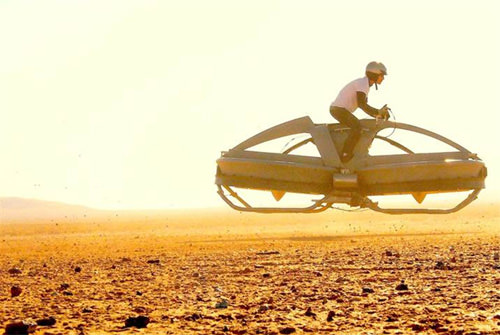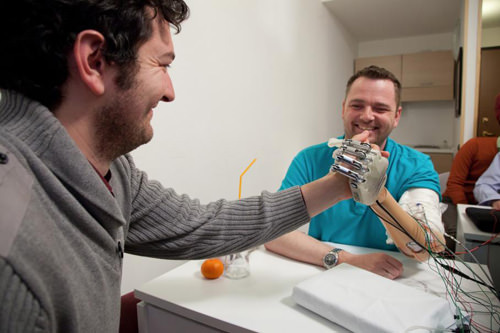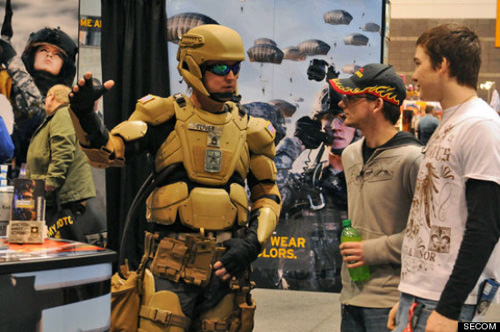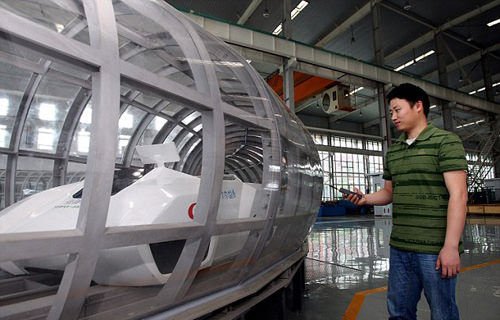Technology and progress never stand still: they are always changing, adapting and evolving, and often things that seem unthinkable (or even impossible) one year can quickly start to become possible just a couple of years later.
Laptops seemed like a quirky idea only recently, but now they're pretty much the next big thing to go mainstream. The arrival of the Oculus Rift could test both the virtual catapult and make virtual reality more real.
With that in mind, here’s a list of 10 interesting futuristic technologies that we’ll likely see in the near future. Although they’re mostly still in the very early stages of development or have already reached the intermediate level of creation. You won’t see them in the public domain just yet, but at least now we know that in due time they’ll become actual products that we can see, touch, and use. Without further ado, here’s the list.
1. Jet Pack International H202
Jet Pack International is making great strides with the H202 and H202-Z jet packs. As the name suggests, both the H202 and H202-Z are hydrogen peroxide jet packs that will allow aircraft to fly at speeds of up to 75 mph (123 km/h) at a maximum altitude of 250 feet (76 meters).
The higher capacity H202-Z is still considered capable of sustaining a maximum flight length of 33 seconds and a maximum flight range of 1 km.

But it must be acknowledged that this is a start. International Jet Pack units have great potential, and the lack of travel time and distance is outweighed by how mobile and controllable the flight is, not to mention how compact the cabins actually are.
The Jet Pack International H202 and H202-Z are actually available now, although not commercially: you can build a jet pack yourself if you have $100,000 to spend.
2. Aerofex Aero-X
If you're a Star Wars fan, the Aerofex Aero-X, the real-life equivalent of the Star Wars Speeders bike, is definitely something to keep an eye on. The Aero-X is the result of over 15 years of research and development.
Powered by a 240 horsepower water-cooled engine and two large rotors, the Aero-Xcan hover at heights of over three meters and at speeds of up to 72 km/h. It can also carry up to 140 kg. One can only imagine the potential.

Additionally, as a result of this extended period of research and development, Aerofex claims to have overcome the dangerous clutch effect that can arise from the use of two rotors, ensuring that the Aero-X is safe and easy to fly.
The Aero-X is currently available for pre-order for a refundable deposit of $5,000. The final unit is slated to ship at $85,000.
3. Prosthetics With A Sense Of Touch
In March 2013, Dennis Aabo Sorensen had the privilege of testing out a new type of prosthetic arm created by a team of European engineers and scientists. Unlike conventional prosthetics, the new prosthetic arm connects directly to the rest of the nerves in Dennis’ shoulder. This means that the “arm” has a sense of touch and is actually controllable.
Blindfold tests showed that Denis could indeed differentiate between different objects, such as a bottle, a baseball cap, and a tangerine. He could also apply different amounts of pressure, allowing Denis to touch, hold, or grab something.

While this prosthetic arm is indeed a big step forward, it is still far from ready for widespread use: the arm requires electrodes to be implanted directly into the body, and testing still needs to be done to determine the durability of these electrodes.
In addition, the arm required a lot of computing power and was connected to a laptop; researchers are working to make the processing computer small enough to be integrated inside the implant itself.
4. TALOS “Iron Man suit”
TALOS is the Tactical Assault Operational Squadron. The combat suit the U.S. Army hopes will become a reality within the next four years. TALOS provides ballistic, impact, and fire protection for Special Forces soldiers.
The goal is to provide these soldiers with better, more mobile, and more versatile protection than they currently have. The development of the TALOS suit will be a collaborative effort between universities, government agencies, and corporations.

While there is still a working prototype, development is proceeding at a rapid pace. Admiral William McRaven, head of the U.S. Special Operations Command, is confident that unpowered prototypes will be ready by June. A goal was also set for August 2018 to test a full working prototype.
Don't expect to be able to buy this, of course, although there's every chance that some of the technology here could eventually trickle down into civilian use.
5. Titan Arm
The Titan Arm is the work of a team from the University of Pennsylvania, and it’s an upper-body exoskeleton that will help you lift an extra 40 pounds. Sure, it’s a far cry from the Powerloader we see—and love—in the Alien movies, but the Titan Arm was designed with a more modest purpose.
The Titan Arm is designed to help rehabilitate people who have suffered serious hand injuries or blows, as well as provide extra strength and protection for those lifting heavy objects.

To keep costs down, the Titan Arm uses 3D printing technology, allowing it to cut the cost of developing a prototype to $1,600. This, and the fact that the developers received additional funding by winning the 2013 James Dyson Award, means that the Titan Arm could become a common sight in the near future.
6. Super Maglev Train
Recently, Chinese researchers have been exploring the next stage of train transportation beyond Maglev technology. China and Japan already have very fast Maglev trains capable of reaching speeds of over 250 mph, but the new next-generation Maglev technology, dubbed super Maglevs, will likely be even faster.

Super Maglev is built on the same Maglev technology, but it encapsulates the train in a vacuum tube, which further reduces air resistance, allowing for faster acceleration. Researchers say such closed-tube Maglev systems could see trains reach speeds of up to 2,000 mph.
Of course, there are doubts about the feasibility of building long vacuum tubes and keeping them under pressure, but if scientists and engineers can figure this out, we may one day be able to travel longer distances more safely and quickly than we could ever imagine.
7. Cave2
Cave2 is a hybrid reality environment that allows artists, scientists, and engineers to fully immerse themselves in their research. Cave2 is a 360-degree structure consisting of 72 LCD panels, a 20-speaker surround sound system, and a 10-camera optical motion tracking system.

With the help of 3D glasses, scientists and engineers will actually be able to practically experience and move anything they want, whether it is the human body or planets in the solar system. Cave2 has great potential, especially for situations involving large amounts of data that require visualization.
In fact, a recent project transferred crime data from the city of Chicago to Cave2, allowing policymakers and investigators to actually fly through Chicago accompanied by real-time crime data and information.
8. 3D Printed Food
3D printing has taken the world by storm and slowly but surely people are getting excited about the idea that it is more than just gadgets. Food is also something that can be 3D printed.
German company Biozoon is harnessing the power of 3D printing to create seneoPro, a range of 3D printed powder mixtures that harden when printed and also melt very quickly when eaten. The main target of this new 3D printable food is elderly patients who suffer from dysphagia, or the inability to swallow.

This technology will certainly reduce the risk of choking, and the 3D printed nature of the seneoPro means that caregivers and family members can mix and match powders very easily to create all sorts of dishes. And you can also add colorings and texturizers to make the food even more appealing.
9. High Power Wireless Charging
Wireless charging still usually means charging through a pad rather than through wires and cables. But if you ask the team at the Korea Institute of Science and Technology, wireless charging can also be done from a distance.

The team recently demonstrated a prototype of a new Dipole Coil Resonant System (DCRS) that can wirelessly control devices up to 5 meters away. The DCRS system achieves this using a magnetic field and is apparently powerful enough to charge up to 40 mobile phones and can even control more powerful devices like a TV.
There's no word yet on how soon we'll see this technology in the real world, but we can already check out Cota, a somewhat similar wireless charging technology that's coming soon.
10. StoreDot Fast Charging Battery
StoreDot, a pioneering nanotechnology company, recently unveiled a prototype for a next-generation battery that leverages its expertise in nanotechnology and energy conservation. StoreDot uses bio-organic “nanodots” that have increased electrode capacity and electrolyte efficiency.

The science is a little complicated, but the result is simple: these nanodots can fully charge a battery in just 30 seconds.
Best of all, because StoreDot nanodots are bio-organic, they are much more environmentally friendly, not to mention energy efficient, than many other competing nanodot technologies, which often use hazardous metals and chemicals. They are also apparently cheap to produce, so who knows, we may see super-fast batteries in our smartphones for a long time to come.
Bonus: “Back To The Future” Hoverboard
Yes, we know, it was a hoax, but for a brief, glorious moment, it felt like all our dreams for the future were coming true: a real, working hanger that wasn’t just a science experiment confined to a lab. The promotional video from HUVr and famous faces like Tony Hawk and Dr. Emmett Brown does everything from skiing to even controlling the canopy from an iPhone.

As it turns out, just a day later the video and the entire canopy were a hoax on Funny or Die, but the fact that it captured the imagination of so many people shows that, yes, people really do want hoverboards. It's safe to say that if resellers ever figure this out, it'll be an achievement no one will ever forget.












